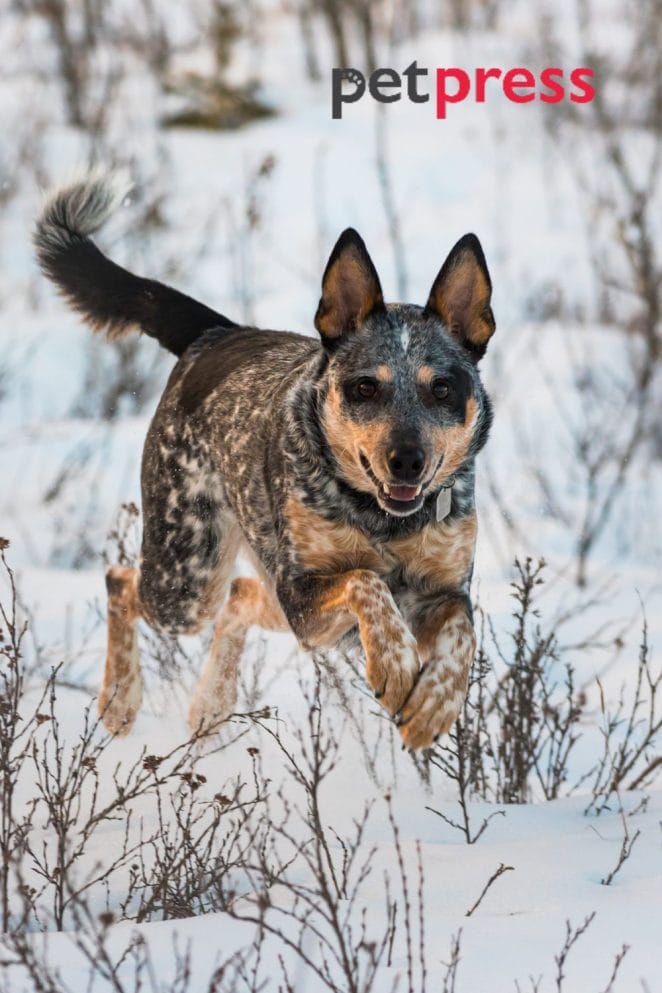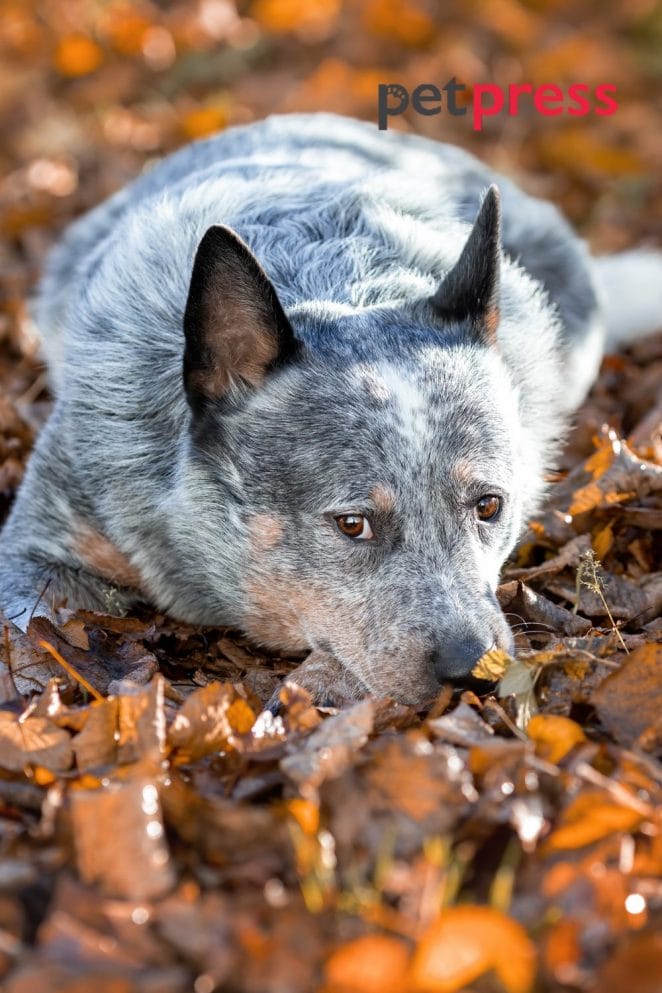
Understanding the Blue Heeler behavior problems is the first step towards a happier, healthier pet. Blue Heelers, active and intelligent dogs, sometimes exhibit behavior issues that can frustrate even the most patient owners.
This guide will delve into common Blue Heeler behavior problems, their causes, and practical solutions to help restore peace in your home.
Interesting Facts about Blue Heeler
Blue Heelers are a fascinating breed known for their distinctive coat color and energetic personalities. Interestingly, their name ‘Blue Heeler‘ stems from their unique herding style: they ‘heel’ (nip at the heels of) cattle to drive them forward.
The mesmerizing blue coats of these creatures are a testament to a fascinating genetic trait. A special gene dilutes the intense black color, giving their coats a captivating blue-gray hue.
Additionally, Blue Heelers are renowned for their intelligence and agility. They were initially bred in Australia in the 19th century to herd cattle over long distances across rough terrain.
The intelligence and agility of Blue Heelers, coupled with a high energy level, make them excellent dogs for work, sports, and competitions. They thrive in environments where they can be mentally and physically challenged.
However, the traits that make Blue Heelers excellent working dogs can also lead to behavior problems if they do not receive adequate mental stimulation and physical exercise. They are known to become destructive and unruly when bored or neglected.
This indicates the importance of understanding and addressing the behavior problems of Blue Heelers to ensure they live fulfilled and balanced lives.

Understanding Blue Heeler Behavior Problems
As with any breed, there can be a range of behavior problems that Blue Heelers may exhibit. Some are more common than others, and some may require professional intervention. Every dog is unique; what works for one may not necessarily work for another.
Common Blue Heeler Behavior Problems:
- Excessive barking: Blue Heelers are vocal dogs who may bark excessively if not appropriately trained.
- Aggression: This can be towards other animals or humans. It is crucial to address aggressive behavior early on before it escalates.
- Separation anxiety: These dogs form strong bonds with their owners and can become anxious when left alone for long periods.
- Nipping and biting: Blue Heelers may exhibit nipping and biting behavior as a herding breed, which needs to be redirected and trained appropriately.
- Hyperactivity: Without proper outlets for their energy, Blue Heelers can become hyperactive and display destructive behavior.
- Stubbornness: These intelligent dogs can also be stubborn, making training a challenge at times.
Causes of Behavior Problems
Understanding the causes of Blue Heeler behavior problems is essential to finding practical solutions. Some possible reasons for these issues include:
- Lack of mental stimulation: These dogs need tasks and challenges to occupy their minds.
- Insufficient exercise: Blue Heelers are high-energy dogs that require regular physical activity to remain content and healthy.
- Improper training or socialization: Blue Heelers may develop unwanted behaviors without proper training and socialization.
- Neglect or boredom: These dogs thrive on attention and can become destructive if left alone for extended periods.
- Health issues: Sometimes, behavior problems may stem from underlying health conditions. It is best to rule out any medical causes before addressing behavioral ones.

5 Best Ways to Address Blue Heeler Behavior Problems
As a responsible pet owner, you must provide the best care for your Blue Heeler. Here are some practical solutions to common behavior problems:
Training and socialization
Starting training early is crucial to preventing or addressing behavior problems. Socializing your dog with other animals and people will also help reduce aggression and anxiety.
For instance, consider a young Blue Heeler exhibiting signs of aggression towards other dogs. A practical training approach could gradually expose the pup to different social situations.
This can be achieved by taking your Blue Heeler to dog parks or arranging playdates with other dogs. These interactions, initially supervised and in controlled environments, can help your dog learn how to behave around others.
To reduce aggressive behavior in pets, gradually increase social interactions through desensitization. Reinforce positive behavior with praise or treats.
Mental stimulation
Mental stimulation is crucial for the well-being of Blue Heelers, given their high intelligence and active disposition. It keeps them engaged and satisfied and helps prevent destructive behaviors stemming from boredom or neglect.
For instance, you could set up an obstacle course in your backyard, incorporating tunnels, jumps, and weave poles. Not only would this provide physical exercise, but it would also challenge your Blue Heeler’s problem-solving skills as they navigate through the course.
Physical exercise
Ensure your dog gets enough physical activity to release pent-up energy. This can include daily walks, runs, or playing fetch.
For instance, a morning jog or bike ride with your Blue Heeler can help them burn off energy and reduce hyperactive tendencies throughout the day. Also, getting them to join in dog sports provides a physical outlet and satisfies their instinctual need for work and task completion.
Positive reinforcement
Reward good behavior with treats and praise to reinforce desired behaviors. Positive reinforcement is a highly effective training technique that encourages dogs to repeat behaviors that result in positive outcomes.
For instance, if your Blue Heeler displays good behavior during socialization or training exercises, immediately reward them with a treat or praise. This helps them associate the behavior with a positive outcome and increases their likelihood of repeating it.
Seek professional help
If your Blue Heeler still has behavior issues despite all your efforts, consider seeking professional help. It is a commitment of responsible pet ownership to provide the best possible care for your furry friend.
A professional dog trainer or behaviorist has the experience and knowledge to manage and address behavior concerns effectively. They can guide you through the process using practical, safe, and humane solutions.
Moreover, a professional can offer support and reassurance during difficult times and assist in strengthening your bond with your pet. Remember that seeking professional assistance is not a sign of failure but rather an acknowledgment of the complexity of behavior issues and

Training Your Blue Heeler Effectively
When training your Blue Heeler, consistency and patience are key. Start by establishing a daily routine, encompassing everything from feeding times to walks and playtime. This helps create a stable environment where your Blue Heeler knows what to expect, reducing anxiety and stubbornness.
Blue Heelers are intelligent dogs, flourishing under positive reinforcement training methods. Praise and reward them immediately for good behavior, using treats and toys. This helps them associate the action with a positive outcome, increasing the likelihood of repeated good behavior.
Because of their herding instinct, Blue Heelers may try to nip or bite. Redirect this behavior by providing appropriate chew toys and discouraging nipping through firm commands and immediate cessation of play.
Socialization is an important aspect of training. Introduce your Blue Heeler to various situations, people, and animals to make them well-rounded and adaptable. Regularly visiting dog parks or organizing playdates with other dogs can be beneficial.
Lastly, don’t shy away from seeking professional help if necessary. Dog trainers and behaviorists are equipped with the tools and knowledge to address stubborn behavior issues and can provide valuable guidance on effectively training your Blue Heeler.
Remember, every dog is unique, and what works for one might not work for another. Be patient and consistent, and listen to your dog’s needs for the most effective training.
Conclusion
In conclusion, Blue Heeler’s behavior problems can be challenging but not impossible. With proper understanding and diligent training and care, you can ensure your Blue Heeler is a well-behaved and happy companion.
Always approach behavioral issues with patience, consistency, and positive reinforcement. By doing so, you and your Blue Heeler can enjoy a fulfilling and harmonious relationship.

FAQs to Blue Heeler Behavior Problems
Blue Heelers are known for their high energy and intelligence. Common behavior problems can include excessive barking, herding behaviors like nipping or biting, and destructive behavior resulting from a lack of mental and physical stimulation.
Proper socialization, consistent training, and positive reinforcement can mitigate aggressive behavior. Seek a professional dog trainer or behaviorist if needed.
Blue Heelers require significant exercise due to their high energy levels and working dog heritage. Ideally, they should have a minimum of 1-2 hours of physical activity daily, including walks, runs, playtime, or participation in dog sports.
Positive reinforcement, such as treats, praise, or toys, can encourage desired behaviors. Additionally, providing mental stimulation through puzzle toys or training sessions can help reduce destructive behaviors.
If your Blue Heeler is still exhibiting problematic behavior, it is highly recommended that you seek the assistance of a professional who can devise a customized training plan and expertly guide you through the process. Remember, seeking professional help signifies your commitment to providing the best care for your beloved pet.

Related Post:
What is a Blue Heeler? A Guide to This Remarkable Breed


GIPHY App Key not set. Please check settings